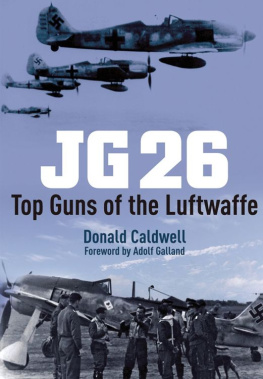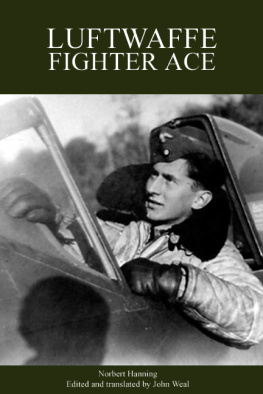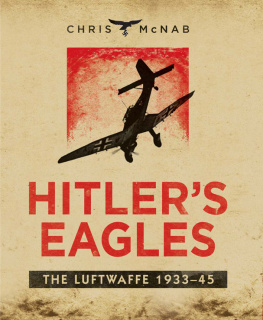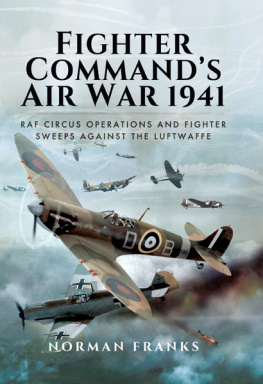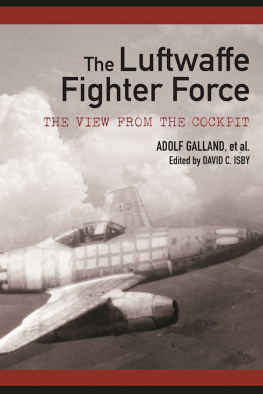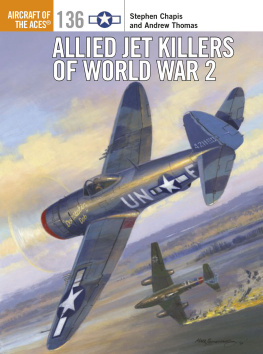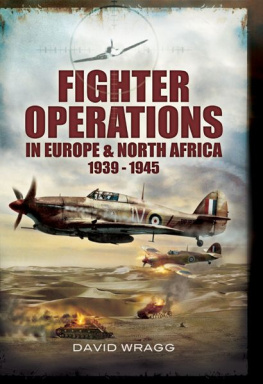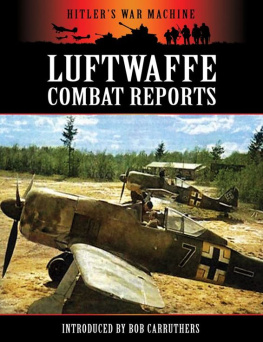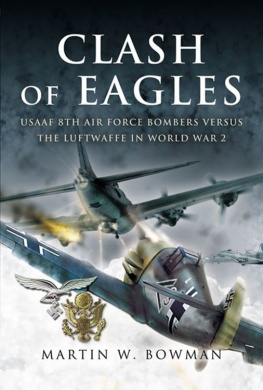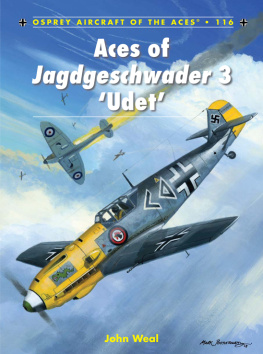JG26
to the fighter pilots
JG26
Top Guns of the
Luftwaffe
Donald Caldwell
Foreword by Adolf Galland
JG26: Top Guns of the Luftwaffe
This edition published in Great Britain in 2013 by Frontline Books
an imprint of Pen & Sword Books Ltd,
47 Church Street, Barnsley, S. Yorkshire, S70 2AS
www.frontline-books.com
Copyright Donald L. Caldwell, 1991
The right of Donald Caldwell to be identified as the author of this work has
been asserted by him in accordance with the Copyright, Designs and Patents
Act 1988.
ISBN: 978-1-84832-746-7
Publishing History
First published in 1991 by Orion Books, New York.
All rights reserved. No part of this publication may be reproduced, stored in
or introduced into a retrieval system, or transmitted, in any form, or by any
means (electronic, mechanical, photocopying, recording or otherwise)
without the prior written permission of the publisher. Any person who does
any unauthorized act in relation to this publication may be liable to criminal
prosecution and civil claims for damages.
CIP data records for this title are available from the British Library
For more information on our books, please visit
www.frontline-books.com, email info@frontline-books.com
or write to us at the above address.
Printed and bound by CPI Group (UK) Ltd, Croydon, CR0 4YY
CONTENTS
Generalleutnant Adolf Galland, Ret.
I AM PLEASED TO COMPLY WITH THE AUTHORS REQUEST TO WRITE A foreword to this book, the first detailed history of a Luftwaffe combat unit to be written by an American in the English language. This unit, Jagdgeschwader 26 Schlageter, JG 26, was one with which I had a long and close relationship. In my travels I am frequently reminded of the English-speaking worlds continued fascination with World War II fighter combat. It is therefore surprising that only a few balanced portrayals of the German side of the air war have appeared in English. Many authors have stressed the exploits of the Experten, or aces, while paying little attention to the day-to-day activities of the fighter units and their average pilots. Before you can claim a true understanding of the air war, you must know something of the accomplishments and sacrifices of the individual combat units. This book thus attempts to fill a real gap.
After the loss of World War I, Germany could only manage to train a few dozen fighter pilots and some reconnaissance crews, contrary to the Versailles treaty. This nucleus was transferred to other assignments and used to build up the entire Luftwaffe, so that the fighter arm was understaffed and played an inferior role as a defense force from the very beginning. Fundamental mistakes were made. Great Britain was never considered as a potential adversary; later, the performance of the young Luftwaffe, which had expanded too rapidly, was totally overestimated.
After using many tricks, I was able to join the Luftwaffe fighter force, and in June 1940 I was transferred to JG 26 to take over its Third Gruppe. From that time on, JG 26 was always my favorite fighter unit in the Luftwaffe. Since my two brothers Paul and Wilhelm, both successful fighter pilots, were killed in JG 26the former as a Staffelkapitaen (Squadron Leader) and the latter as a Gruppenkommandeur (Group Commander)this has indeed been my wing.
You might well wonder, as I did, why the author, who is an American and a member of the postwar generation, selected JG 26 as the subject of his book. He has told me that he originally planned to write a history of the Jagdwaffe, the Luftwaffes fighter arm. A desire to stress the human side of Luftwaffe service forced him to narrow his scope, and his attention was ultimately drawn to JG 26, one of the best German fighter units for much of the war, and the one most respected by the Royal Air Force and the United States Army Air Force. The history of this one unit encompasses in microcosm the rise and fall of the entire German fighter arm, and it remains the Luftwaffe unit best known in the English-speaking worldalthough as the Abbeville Kids rather than by its correct designation. The author interviewed fifty former members of JG 26, from Kommodore to enlisted pilot, plus many members of the ground staff. To ensure the impartiality and completeness of the book, the official records of both sides were searched, and the true course of events in a number of air battles was reestablished for the first time. In its quest for historical objectivity, the book does not gloss over unpleasant facts, especially those concerning conditions in the late 19441945 Luftwaffe, after the course of the war had turned irrevocably against Germany. It is almost a miracle that the complete breakdown of pilot morale did not occur prior to D-Day in 1944, when the total collapse was more than obvious.
Even though there is an excellent German history of JG 26 in existence, written by Josef Priller and Otto Boehm, the present work is the best fulfillment that we could wish for. The book inevitably contains errorsthe Luftwaffe destroyed most of its records at wars end, and mens memories of events fifty years ago must be considered fallible. Nevertheless, I feel that this book, with its unique perspective on the air war, is a suitable memorial to the fallen men of Jagdgeschwader 26 Schlageter.
Thanks to Donald L. Caldwell, and success to his profound book, written in full fairness.
ADOLF GALLAND
January 1991
MY GREATEST DEBT OF GRATITUDE IS OWED TO THE VETERANS OF THE Geschwader whose enthusiastic cooperation made this book possible. I shall never cease to be amazed that my written appeals for assistancewhich came from a stranger, a novice author, and a former enemywere answered with such an outpouring of documents, photographs, and amazingly frank first-person accounts. I am proud that I can now call many of these men my friends. They are: Hermann Ayerle, Ernst Battmer, F. W. Bauerhenne, Guenther Bloemertz, Karl Boehm-Tettelbach, Matthias Buchmann, Joseph Buerschgens, Peter Crump, Heinz Ebeling (deceased), Georg Eder (deceased), Guenther Egli, Xaver Ellenrieder, Adolf Galland, Heinz Gehrke, Georg Genth, Adolf Glunz, Alfred Heckmann, Walter Horten, Erich Jauer, Gerhard Kemen, Gerhard Kroll, Walter Krupinski, Ottomar Kruse, Hans Kukla, Erwin Leykauf, Willi Luerding, Werner Molge, Johannes Naumann, Edu Neumann, Josef Niesmak, Wolfgang Pils, Rolf Pingel, Wolfgang Polster, Hans Prager, Hans-Werner Regenauer, Heinrich Schild, Gottfried Schmidt, Walter Schmidt, Friedrich Schneider, Gerhard Schoepfel, Rolf Schroedter (deceased), Otto Stammberger, Walter Stumpf, Siegfried Sy (deceased), Erhard Tippe, Fritz Ungar, and Gerd Wiegand. Special thanks are owed to Adolf Galland for the foreword and to Joseph Buerschgens for hand-carrying it and the manuscript across two continents.
My search for participants from the other side, while neces sarily less exhaustive, was equally rewarding. My thanks go to the following USAAF and RCAF veterans: William Beyer, William Binnebose, George Brooks, William Capron, George Carpenter, H. H. Christensen, Elmer Clarey, McCauley Clark, Darrell Cramer, Jack Curtis, Bernard Dennehy, James Doyle, Walker Mahurin, Merle Olmsted, Chet Patterson, Herman Schonenberg, Robert Seelos, Luther Smith, Rod Smith, John Truluck, George van den Heuvel, Chuck Yeager, and Hubert Zemke.

